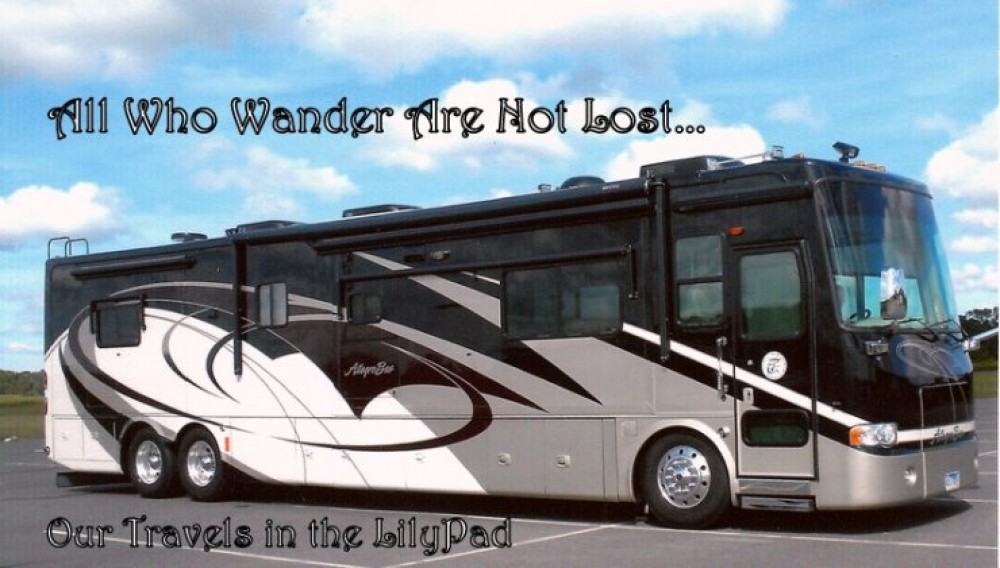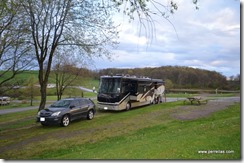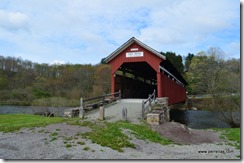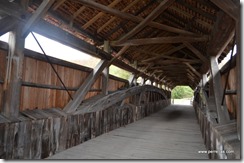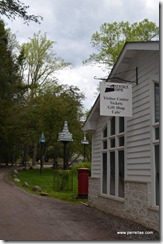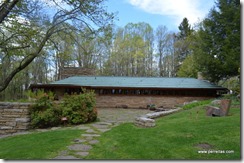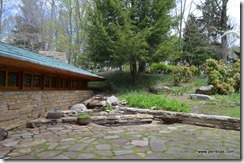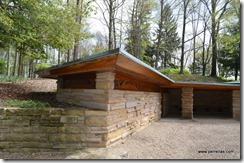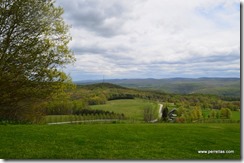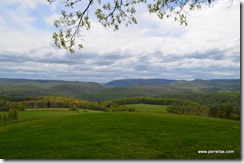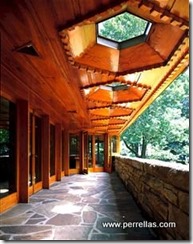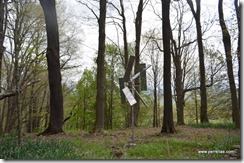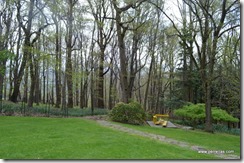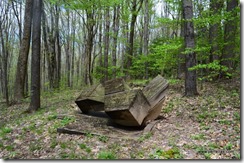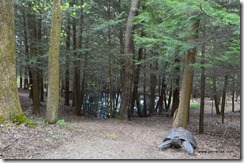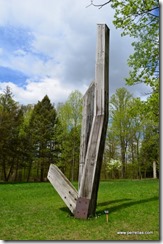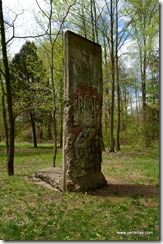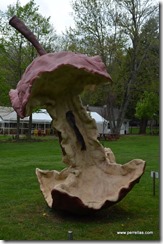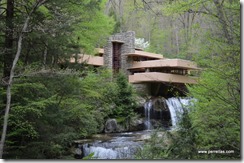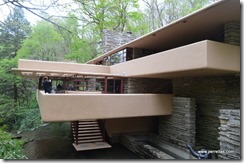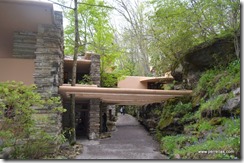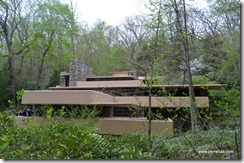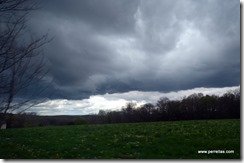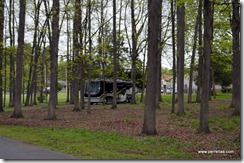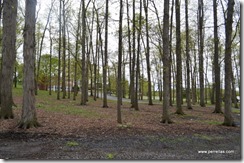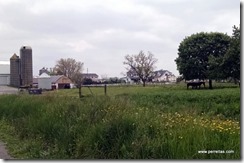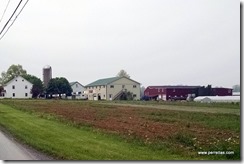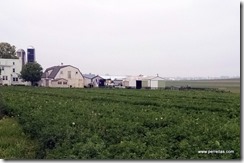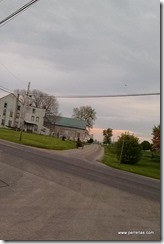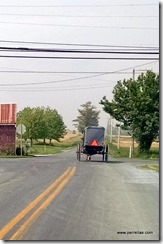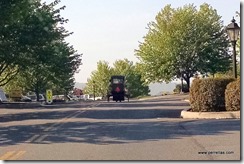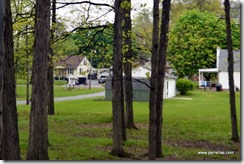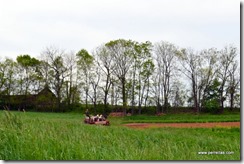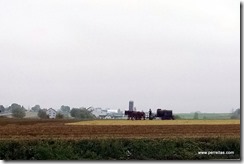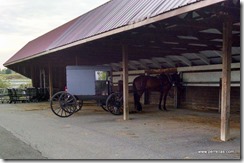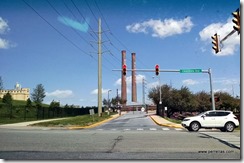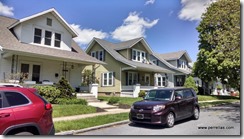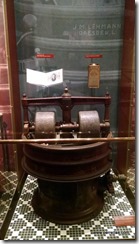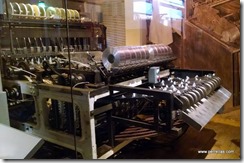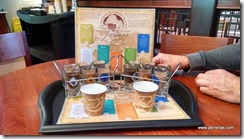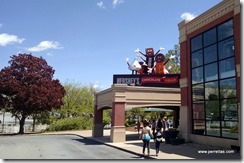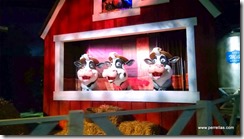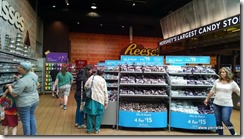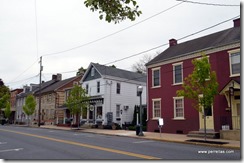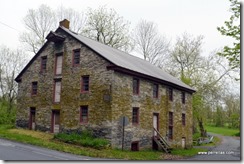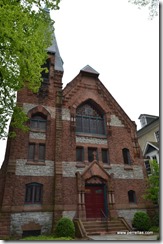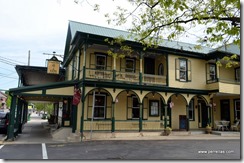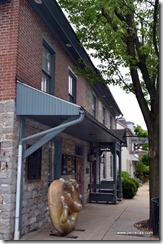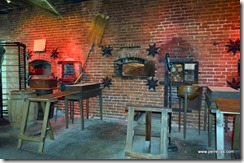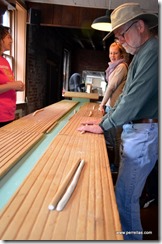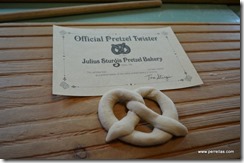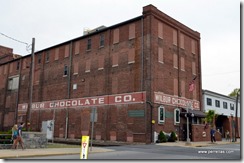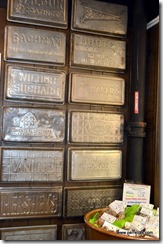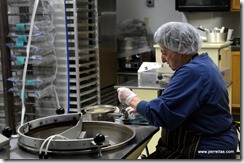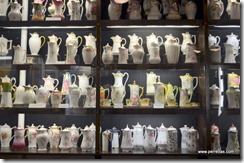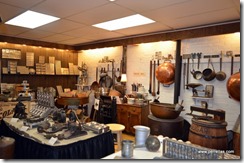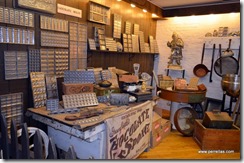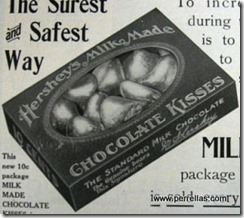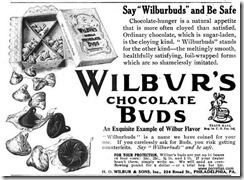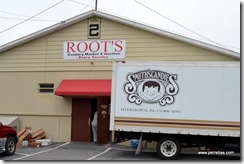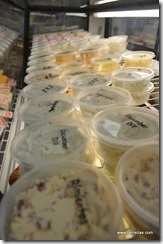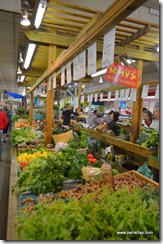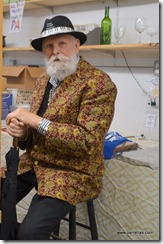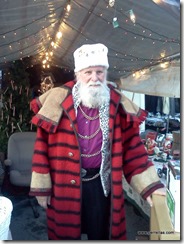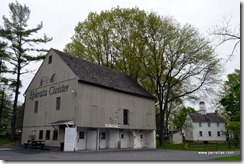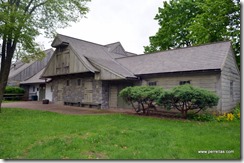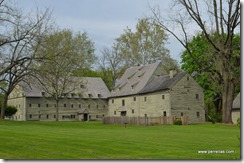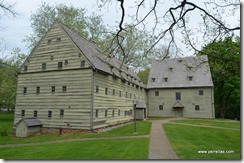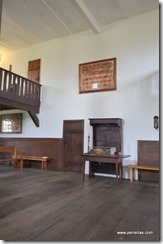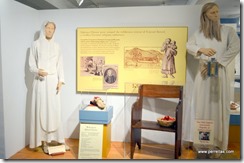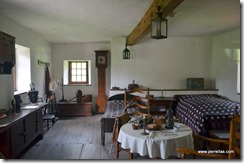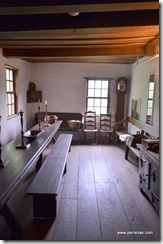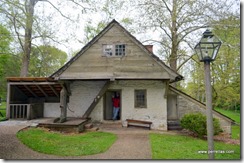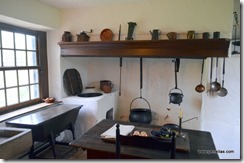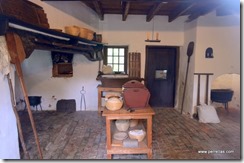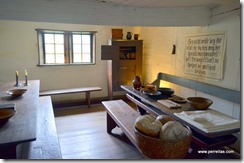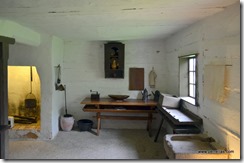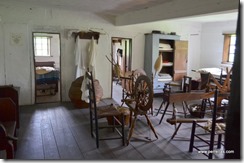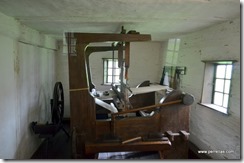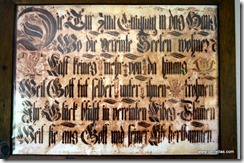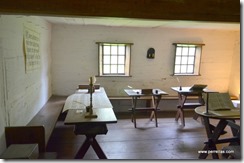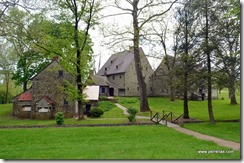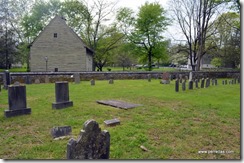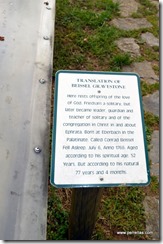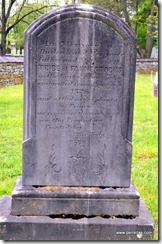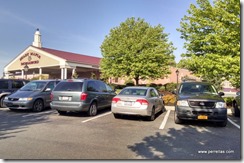On our way to Pennsylvania Dutch Country we paused for a tour of two Frank Lloyd Wright homes, Kentuck Knob in Chalk Hill and Fallingwater in Mill Run Pennsylvania. The homes were located within a few miles of each other. Our overnight for this off- track visit was Hickory Hollow RV Park. To reach the campground it was necessary to wind through steep hills, down narrow roads, and cross several bridges with signs warning “no trucks over 10 tons”. White knuckling it with fingers crossed, we rolled over several holding our breath and hoping that our 20 ton heft didn’t collapse the small bridges.
Arriving safely we pulled into our partially shaded long level site and set up for the night. Our site was on the ridge, no one else as neighbors, with views of the tranquil rolling hills and peaceful fishing lake. When night arrived, it was pitch black with tiny piercing white stars covering the sky. After an overload of travel stress, we slipped into an evening of pure relaxation.
There were a few small downsides to the campground, low water pressure and muddy grounds from the storms, but the area was clean and neat, the staff was friendly, the facilities were modern and nights were quiet. I suspected that our exit, a tight turn on an uphill slant, was going to be problematic but I would worry about that later.
Bright and early next morning, we set off to visit the two Unitarian Style homes designed by Frank Lloyd Wright. Alongside the road we spotted a beautiful covered bridge, Kings Bridge, built in 1806. It is a 127 foot 4 inch long Burr truss bridge. I was surprised to find it had an asbestos covered gable roof, although it would have only been a danger to those who built the roof. Love the design and how well these covered bridges have held up over the centuries. The bridge crosses Laurel Hill Creek. It is one of 10 covered bridges in Somerset County. If we were staying longer in the area, we would search them out.
Arriving early with the dew still on the ground, we walked around the visitor center at Kentuck Knob. As is standard with Frank Lloyd Wright’s homes, no pictures are allowed inside.
Kentuck Knob was designed in 1953 for the Hagan’s and their 80 acres of land. They lived in the home for almost 30 years. Owners of a major dairy company, they were friends of the Kaufmann’s, owners of the nearby Fallingwater home, also designed by Wright, and were frequent guests. The Kaufmann’s helped convince Wright to design a home for the Hagan’s, as even at the age of 86, he was still much in demand.
The 240 degree L-plan house, based on a module system, curves around a courtyard and blends into the land’s contours. Wright wanted the first impression of the house to have the appearance of it emerging from the ground and nestling into the hillside.
The hilltop, a few yards south of the home, has a magnificent view of the valley.
In 1986 Lord and Lady Palumbo of the UK bought the property, using it as a vacation home. The couple occasionally use the home for entertaining but since 1996, they allow the public tour program to continue, a method of historic property management common to Britain.
One of the notable features of the home were the hexagon shaped windows allowing light to come through the overhang on the long rear porch. The picture below is compliments of the website.
Lord and Lady Palumbo have a substantial collection of large scale art pieces located along a half mile trail called “Sculpture Meadow”. Beginning near the stunning valley overlook behind the house, and ending at the Visitors Center where we were parked, the perfect weather and interesting pieces made for an enjoyable purposeful walking exercise through the forest.
Kinetic Art Bailey Sculpture
De Creation Sculpture Troilus Tortoise bronze sculpture
Untitled Sculpture Berlin Wall Section Apple Core Sculpture
The Kaufmann residence, also known as Fallingwater, was designed by Frank Lloyd Wright in 1935 for Edgar J. Kaufmann, owner of Kaufmann’s Department Store.
The home was built partially over a waterfall on Bear Run in the Mill Run section of Stewart township and the multi-level home has direct access to a swim deck and swim hole just above the falls. The entrance to the house was tucked away under stone columns and cement overhangs.
It was designed as a weekend home for the family. Wright designed a later addition, on a hill above the family home, as a guest home with a back deck that included a natural spring fed swim pool. You can barely see the guest house over the top of the main house.
While I was drawn to Wright’s earlier work, the older and more famous he became, the less I appreciated his architectural reasoning. Narrow dark entrances with low ceilings that opened up and made rooms look larger was appealing but his determination to have total control over the design went awry with several inconvenient features.
His insistence on low ceilings at the entrances left anyone six feet tall or over having to duck their heads to enter his homes. Another insisted design feature was the absence of screens. The intricately designed woodwork across opening windows allowed cross breezes to flow but also allowed in bugs and critters. Wright did not allow screens. He believed they blocked the progression of the outdoors into the indoors, despite the damage that resulted from entering crawlies and creepers. Many of the home owners sensibly added screens after the home was completed.
Built-in seating that stretches along walls and discourages intimate guest conversations was another odd feature. Both homes were owned by well-to-do families that entertained. The odd seating and small dining tables that have seating designed for only immediate family added to the clash, pulling the home’s purpose in opposite directions. The narrow stone passageways designed as halls were uncomfortably claustrophobic and kitchens were designed for preparation of small meals with little storage.
Mr. Wright would never have been able to complete an agreeable home design for John and I. He believed that everyone was entitled to his opinion but then, so do I. One of us would surely have ended up buried six feet under a solid cement foundation before the house was completed.
Near both homes is the small town center of Ohiopyle. It is quaint, sits alongside the river, is filled with small shops and eateries and is the center for dozens of activities and outdoor adventures. Ohiopyle State Park’s 20,500 spectacularly scenic acres, the Youghiogheny River and waterfalls make this area a quality one-on-one experience with Mother Nature. We had lunch in a small café across the street from the river and drove around the area sightseeing before returning to LilyPad to pack up and prepare for our early morning departure.
Our morning exit was complicated by the downpours that happened sporadically over the past two days. The rain produced wet grounds, wet grass and some areas of mud with less-than-perfect road conditions. It resulted in LilyPad sliding as we climbed the hill to exit the campground. Stopping each time the wheels spun, we inched our way up, thankfully without having to unhook the car, my teeth clenched tight throughout our sluggish climb and eventual exit. Relaxation, stress, relaxation, stress…there is always a roller coaster of emotions each travel day.
Soon I will be checking off something on my Bucket List and am happily anticipating the experience the nearer we draw to our next destination. A visit to Lancaster, PA has been on my Bucket List for decades and shortly we will arrive. Reading up on both religious groups for a better understanding of each, the people and the area, was done nightly over the past week.
Wikipedia describes the Amish as a group of traditionalist Christian church fellowships with Swiss Anabaptist origins. They are closely related to, but distinct from, Mennonite churches. The Amish are known for simple living, plain dress, and reluctance to adopt the many conveniences of modern technology. The history of the Amish church began with a schism in Switzerland within a group of Swiss and Alsatian Anabaptists in 1693 led by Jakob Ammann. Those who followed Ammann became known as Amish.
The same source describes the Mennonites as Christian groups belonging to the church communities of Anabaptist denominations named after Menno Simons (1496-1561) of Friesland in what is now the Netherlands. The early teachings of the Mennonites were founded on the belief in both the mission and ministry of Jesus, which the original Anabaptist followers held to with great conviction despite persecution by various Roman Catholic and Protestant states. Rather than fight, the majority of these followers survived by fleeing to neighboring states. Mennonites have become known as one of the historic peace churches because of their commitment to pacifism.
Although Lancaster , in the heart of Amish and Mennonite country, was our original destination, we settled comfortably in Ephrata at the Ephrata Elks Lodge, tucked between dozens of Shaggy Hickory trees and a short distance away from the Lodge. It is an effortless drive to any town we wish to visit.
Capturing the Amish on film, being mindful of their intense faith and strict adherence to traditions, is a delicate task and not easily accomplished as they are integrated within the county. They hold a fascination for myself and many other “English”, which is what they call outsiders. Their culture is marked by separatism and a rejection of modern technology even as they continue to thrive within communities that so passionately embrace individualism and staying connected to a state-of-the-art world.
We began our Amish adventure by traveling over roads that split fields of chestnut colored soil, dotted every so often by plain white houses and barns, all lacking “English” electrical pole and phone line attachments to their homes. A red barn among the white buildings often implied a Mennonite farm.
Simple somber blue, white, tan and brown colored clothing, hand washed and hanging wet on outdoor clotheslines, were a common site.
While driving along, one had to be watchful of horse drawn carriages touring briskly down asphalt roads, sharing lanes with motor vehicles.
Some even traveled down the road where we were staying.
Teams of colossal horses, guided by a single farm hand, working in unison to drag plow equipment across fields, turning lush greenery into fertile tilled soil.
Restaurants and grocery stores offered horse and carriage parking.
Each of these scenes were all signs that we had truly entered Pennsylvania Dutch Country.
Our first excursion was to Hershey Museum in Hershey Pennsylvania. My keep-on-rollin-on mantra is: Just give me chocolate and no one gets hurt. Chocolate is my drug of choice. It has become a powerful tool in stress reduction or any other excuse I can dream up in order to bite into a square of my velvety addiction.
Milton Hershey’s chocolate factory provided affordable chocolate to all Americans but that was only one of his gifts to this country.
I had read about the Milton Hershey empire before we visited but didn’t realize how much was not included in the writings. He was a devout philanthropist, designing a company town that encouraged his employees to seek education, offering them a well-rounded life that included sports and the arts, availing loans for them to purchase housing, building swimming and sports facilities for leisure time and constructing a gigantic community building for offering a variety of events and gatherings. Hershey was one of the first successful planned communities. Neither he nor his wife had children and he left his fortune to the Hershey Industrial School, a home for orphaned boys which he founded in early 1900.
We drove through the neighborhoods where Hershey employee homes still stand. Lovely homes, well manicured neighborhoods.
Hershey began his confectionary business with Lancaster Caramel Company which quickly became successful. Using the funds from the sale of his caramel company to build The Hershey Company, he established the Hershey Industrial School for orphaned boys with a Deed of Trust in 1909 and in 1918 he transferred the majority of his assets, including control of the company, to the Milton Hershey School Trust fund, renamed in 1951 to the Milton Hershey School. The school trust has 100 percent control of Hershey Entertainment and Resorts Company which owns the Hotel Hershey and Hersheypark among other properties. Milton took great pride in the growth of the school, his town and business, placing the quality of his products and the well-being of his workers ahead of profits.
The museum was a wealth of information about the chocolate making process. Original manufacturing machines were displayed in several rooms along with the process used to make the chocolate and lots of interactive screens to keep the kids entertained.
There was a cocoa bean grinder,
and the Hershey kiss wrapping machine.
We purchased a Groupon for the museum that included a “drinking chocolate” flight. Six different flavors and densities made from beans around the world. From milk chocolate to dark chocolate, each had a different yet amazing flavor. We left with major chocolate highs.
Hershey’s Chocolate World was a short drive from the museum and the heavenly bouquet of chocolate filled the air even before entering the doors.
There was an enjoyable animated ride with funny singing cows,
samples at the end of the ride and more chocolate than imaginable divided among dozens of rooms.
The M.S. Hershey private charitable foundation established in 1935 provides educational and cultural opportunities for Hershey residents. The foundation funds the Hershey Museum, Hershey Gardens and Hershey Theater.
The Penn State Milton S. Hershey Medical Center was founded by an initial endowment of $50 million, a gift from the Milton Hershey School Trust to the people of Hershey PA. The teaching hospital has an annual budget exceeding the initial construction cost.
In 1912, the Hershey’s were booked to travel on the ill-fated maiden voyage of the RMS Titanic. They cancelled the reservations at the last minute, instead booking passage to New York on the German luxury liner SS Amerika. The loss of Milton Hershey would have affected generations of Americans and legal immigrants who benefited from his continuing generosity.
Another day, another town to explore. Today our pick is Lititz, a borough in Lancaster County. Founded by members of the Moravian church in 1756, its name was taken from a German castle near a village where ancient Bohemian Brethren’s Church had been founded in 1457. The historic picturesque downtown is filled with remarkably well preserved stone and wood buildings, some dating back several centuries. I would have no objection to living in any of the buildings, anywhere along the downtown streets of this fascinating town.
Lititz is home to Linden Hall, the oldest all-girls boarding school in the United States. The school was founded by the Moravian church in 1746 as a day school, a decade before the borough was incorporated. An amazing stone building surrounded by beautiful grounds.
Our day started with breakfast at Tomato Pie Café, an eclectic urban style eatery in a vintage building. Friendly service, expansive menu, yummy food.
We walked along the downtown streets, window shopping until we found Julius Sturgis Pretzel Bakery and entered for the bakery tour. I had read about the tour, it sounded interesting and indeed, was worth the time spent. Founded in 1861, the bakery is the first commercial pretzel bakery in America. The smell of fresh baked pretzels wafted through the gift shop so we split a soft pretzel and covered it with spicy brown mustard, munching while waiting for the tour to begin.
Although the exact origin of the pretzel is unknown, legend claims that around A.D. 610, Italian monks rewarded their young students with baked dough twisted in the shape of crossed arms. At that time, the traditional posture for prayer involved crossing arms over the chest, hands flat against the shoulders. The pretzel’s three holes represent the Holy Trinity – Father, Son and Holy Spirit and the bakery item became associated with good luck, long life and prosperity.
The Catholic Church dictated strict rules for fasting and abstinence during Lent in the seventh century so the pretzel, made of water, flour and salt, was an ideal food. These early pretzels were soft baked and were originally called “bracellae”, the later term for “little arms”, from which the Germans later derived the word “bretzel”. According to the church, the earliest pretzels were called “pretiolas”, meaning little rewards, and handed out by monks when their pupils recited prayers correctly.
Spreading across Europe during the Middle Ages, these pretzels were easy to prepare in ovens like the ones we toured at the bakery that are pictured below and pretzels were commonly distributed to the poor as a way of providing both spiritual and literal sustenance.
Our tour guide taught us the original meaning of the shape of the pretzel, allowing us to use raw dough while she explained each step. First, roll the dough ball out to the length of the dowel, approximately 12 inches.
Second, bring ends up to form a “U” representing a child’s prayers going up to heaven. Third, cross the ends of the dough to form an “X”, then twist one time. This knot represents the union of marriage between the child’s parents. Fourth, pull the ends of the dough down and press them into the bottom of the pretzel. The three openings represent the Christian Trinity. The shape also resembles a child’s arms crossed in prayer.
We accepted our complimentary packages of hard pretzels, bought another soft pretzel to share and continued walking around town.
Just before reaching our car, I spied the word “chocolate” on an old building across the street. We were not leaving until I had a taste of what was sure to be stashed inside the Wilbur Chocolate Company.
Purchased by Cargill Cocoa and Chocolate North America in 1992, the company was founded in 1865 by Henry Oscar Wilbur and Samuel Croft in Lititz, where most of the Wilbur brand was produced. It is one of the four brands manufactured by Cargill Cocoa & Chocolate North America. The parent company produces hundreds of millions of pounds of chocolate a year and sells to dozens of manufacturers throughout the Americas. The museum held a wall of molds for brick chocolate and many of the names were immediately recognizable.
Cargill cocoa and chocolate labels include Peter’s Chocolate, bought from Nestle in 2002, Gerkens Cacao and Veliche Belgian chocolate. Cargill closed the Wilbur Chocolate Factory in early 2016 officially ending Wilbur’s celebrated 125 year old tradition of chocolate making in Lititz.
Happily for us, they kept the gratis Candy Americana Museum that tells the story of the company and how their chocolate was made. They also have free samples. Hooray for samples! Although they closed the factory, workers hand fill chocolate molds for sale in the store.
We strolled through the exhibits and I paused in front of the full wall of dainty porcelain antique chocolate pots, exquisitely designed. I inherited my mother’s antique chocolate pot set and I am amazed that something so delicate survived for so many centuries.
The museum also included a room full of tins and boxes, molds and chocolate miscellaneous.
Here is an interesting fact for your Trivia file. The Wilbur Bud was introduced in 1893 and closely resembles the Hershey’s Kiss which debuted in 1907. Although both are chocolate and both are wrapped, doesn’t it seems strange that one is well known and the other almost obscure considering the close proximity of their manufacturers? Lititz is a mere 20 miles from Hershey.
After sampling our fill of chocolate, we drove around while I picked out a few dozen houses where I knew I could live happily ever after. I pretend we will buy a house in one of these towns and John plays along. It works for my imagination of home ownership and John’s lack of ability to buy a sticks and bricks home. I must admit, if I had been to this part of Pennsylvania before living in Boston, I would have lost my heart to the charming little town of Lititz.
Returning to LilyPad for the evening, we made plans to rise early and attend a local farmers market.
It was an overcast day, perfect for wandering through the indoor market and outside stalls. Roots Country Market and Auction in Manheim Pennsylvania is the oldest single family-run country market in Lancaster County. It began as a poultry auction in 1925 and over the years, has evolved into a part of Lancaster County’s heritage, offering fresh foods along with a large variety of handcrafted items for sale.
The country market was a jumble of bakery goods, cheese, fresh fruits and veggies, flowers, handmade baskets and blankets, fish, deli meats and fresh meats, jewelry, handmade wooden items, antiques and scads more, all temptingly exhibited under numerous roofs and spilling out onto the side streets. We didn’t go to the auction. Neither of us could think of a single item we needed badly enough to buy it by the box, and haul it around in our motorhome.
I had to be cautious taking pictures as most of the produce farm stands, dairy farm counters and meat merchant cases were Amish owned and staffed. I tasted everything that was available for sampling, all of it delightfully palate pleasing. Our special treat was a melt-in-your-mouth sticky bun from Michael’s Home-style Breads Bakery.
We took home a selection of Amish homemade sausages, Amish homemade sauerkraut, Amish homemade goat cheese spread (a yummy Cajun spice and crab combo) and a small Amish handmade basket. Prices were low, quality was exceptional, the market was brimming with first-rate people watching opportunities and it ranked high up there on my happy camper meter.
We walked through several buildings. At the end of one of the buildings sat a gentleman dressed to the nines.
I must preface the meeting of this Lancaster county resident by stating that in The Woodlands Texas, our Santa ranked supreme among Santa’s. Search as we might, year after year, none compared to our Santa’s authenticity and exceptional Santa-like demeanor, until this exact moment.
I stopped to chat with this fascinating looking character who introduced himself to me simply as “Santa”. I visited with Santa, a.k.a. Louis Meevers-Scholte, for a while before I realized that his life was so full of amazing experiences and such a positive influence in the world, it would have been a genuine honor to have known him throughout his life’s journey.
Santa is as serious about the name as he is about the title’s obligation. He has been donning the Father Christmas suit for more than 45 years.
Throughout the year he collects food and toys, about 3,000 gifts, to be distributed to the less fortunate homes and children for Christmas. Now in his 80’s he reflects on his life as a musician, lyricist, story teller and Santa. His book, “Look Only Upward – A Reason to Be Born” is his story, his travels through a lifetime. From snippets of his conversation, I began to understand how difficult a journey he had traveled.
His childhood life was one of sorrow and suffering during World War II in Nazi-occupied Holland. When he was 10, he was with his father, a Jewish member of the underground resistance, while his father was tortured and killed. Remarkably, he made his way to America and Pennsylvania while still a child. Years later he was able to bring over his Christian mother.
The bitterness for all Germans eventually faded as he lived and worked among the Amish in Pennsylvania. He became friends with them and credits the friendships that developed between them as the reason he overcame his hatred for Germans.
I thanked Santa, thinking to myself how infinitesimal most troubles seem compared to his lifelong struggles and how tremendous were his contributions to his adopted town. I walked back to our car and resolved to add reading his book to my Bucket List.
On a large parcel of land near the town of Ephrata sat a number of unique European style buildings, giant in size, a few being multiple stories high and all dull in color. The name on the side of the building nearest the road read, “Ephrata Cloister”. We were about to walk in the footsteps of German settlers who came to Pennsylvania in the 1700’s seeking spiritual goals rather than earthly rewards.
We bought tickets in the Visitors Center (picture on the right) which held articles that belonged to the Cloister and we watched a short film about how the Cloister evolved.
The community consisted of celibate Brothers and Sisters and a married congregation of families making up one of the oldest religious cults in America.
Founded in 1732 and at its pinnacle in the 1740’s and 1750’s, the community of about 300 members worked and worshiped at the Cloister. Their lives were structured, orderly and benevolently guided by Conrad Beissel (1691-1768) founder and Superintendent of the Ephrata Cloister. Conrad was one of America’s earliest composers of hymns and anthems, organizer and teacher of the cloister singing school and publisher of America’s first book of original compositions, the Turtel-Taube, 1747.
Born at the end of a century of devastating wars in Eberbach am Neckar Germany, Conrad was orphaned by the age of 8, learned the trade of baker and began traveling the region to perfect his skills. He encountered Pietists who met in small groups not sanctioned by the church to read the Bible and pray.
Eventually banished from his homeland by the government in 1720, he immigrated to Pennsylvania attracted by William Penn’s policies offering freedom of conscience.
Moving to the Conestoga area, he joined with the Brethren, an Anabaptist group who offered admission to the faith to those who had reached maturity. He was appointed leader in 1724. His radical ideas of Saturday worship and promotion of celibacy caused a split within the congregation and in 1728 Beissel withdrew his membership from the church.
Because of his charismatic personality, he attracted followers until 1732 when he left and sought the hermit’s life. Settling along the banks of the Cocalico Creek in northern Lancaster County, he was followed by like-minded men and women wishing to follow his teachings.
Beginning as a hermitage for a small group of devout individuals, the community grew to include nearly 80 celibate members supported by nearly 200 family members. Beissel’s theology, a hybrid of pietism and mysticism, encouraged celibacy, Sabbath worship, delaying baptism until the candidate reached maturity and a self-denying lifestyle.
Our tour guide walked us through several building, explaining and answering questions about life in the Cloister. The meeting house (smaller building) was impressive, open, airy and light.
The Brothers and Sisters slept in small sparse rooms, in separate buildings, for no longer than 6 hours per night on wood benches with blocks of wood for pillows. Their garments were plain and uncolored.
The cloister provided room for families and their own dining room, not luxurious but comfortable.
The families cooked, baked and helped with other needs of the cloister community.
Front of the bakery Back of the bakery
Inside the bakery
Sisters dining hall and Sisters kitchen, minimal but sufficient.
There was limited industry. They made their own furniture in the carpentry shop. 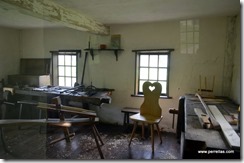
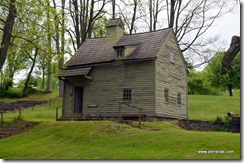
They spun the wool from the sheep they raised and wove their own cloth.
Creative expression was encouraged and the cloister became known for self-composed A Cappella music, Germanic calligraphy known as Frakturschriften and a complete publishing center with a paper mill, printing office and book bindery.
The Cloister originally contained no less than eight major structures, dormitories or meetinghouses, several smaller dwellings, workshops and mills and a cemetery.
In 1745 an internal disharmony came to a head when there was a dramatic challenge to leadership posed by Israel Eckerlin. Israel was expelled from Ephrata.
In 1768, with the death of Beissel, the society quickly declined. His successor, Peter Miller, realized that the monastic life was no longer attractive to new generations. In a letter written to Benjamin Franklin he stated, “the mind of Americans is bent another way”.
The last of the celibate members died in 1813 and the following year the remaining members of the married congregation formed the German Seventh Day Baptist Church. Poor members of the church moved into many of the original buildings on the Cloister property and altered the spaces to fit their needs.
By 1929 the remaining church members living at the Cloister were in disagreement regarding the disposition of the site and its artifacts and took legal action against one another. In 1934 the court system revoked the incorporation charter for the Church at Ephrata and the property was placed under the care of a court receiver who sold the remaining 28 acres of the historic site to the Commonwealth of Pennsylvania in 1941. Restoration on the nine surviving original buildings began immediately.
We walked through the gift shop and museum before the tour and afterwards we walked around the property poking around inside the many buildings on the grounds. A full day under our belts, we returned to LilyPad relaxing under cover of the Shaggy Hickory trees.
John chose our next town. Breakfast at LilyPad and then off to Intercourse Pennsylvania.
We toured the back roads before stopping at The Amish Experience to ride in an Amish carriage and view Amish farms. After, we watched a multi-media show about Jacob, a young man going through Rumspringa, a time period in the life of youths where each is allowed to participate in “English” experiences until he chooses baptism within the Amish Church or leaves the community. As a courtesy, I chose not to attempt taking pictures.
Back to LilyPad for dinner and a Red Box movie. We remain, our entire stay, the only people camping on the peaceful wooded grounds of Ephrata Elks Lodge.
Pennsylvania brought another “Best of” to my list. Best Smorgasbord: Shady Maple Smorgasbord, Blue Ball, Pennsylvania. It was approximately 40,000 square feet on the restaurant floor with a gift shop of the same size downstairs. Vegas style buffet supersized!
You may wonder why several of the towns in this area have unusual and somewhat provocative names considering the large numbers of puritanical residents. Well, wonder no more!
The town of Blue Ball was named after a two century old hotel that was built in Earl Town. The owner hung a blue ball on a post outside the hotel and called it “The Sign of the Blue Ball”. Locals began calling the town “Blue Ball” after the inn. In 1833, Earl Town officially changed its name to Blue Ball.
The town of Intercourse was founded in 1754. The community was originally named Cross Keys, after a local tavern. Intercourse became the name in 1814. The use of language during the early days of the Village may have resulted in the name change. According to the Village website, “The word ‘intercourse’ was commonly used to describe the ‘fellowship’ and ‘social interaction and support’ shared in the community of faith, which was much a part of a rural village like this one”. And now you know the rest of the story.
Back to Ephrata to ready LilyPad for our departure and our next adventure. We will be moving on to Beacon New York where we will meet up with friends from Texas and tour West Point together.
